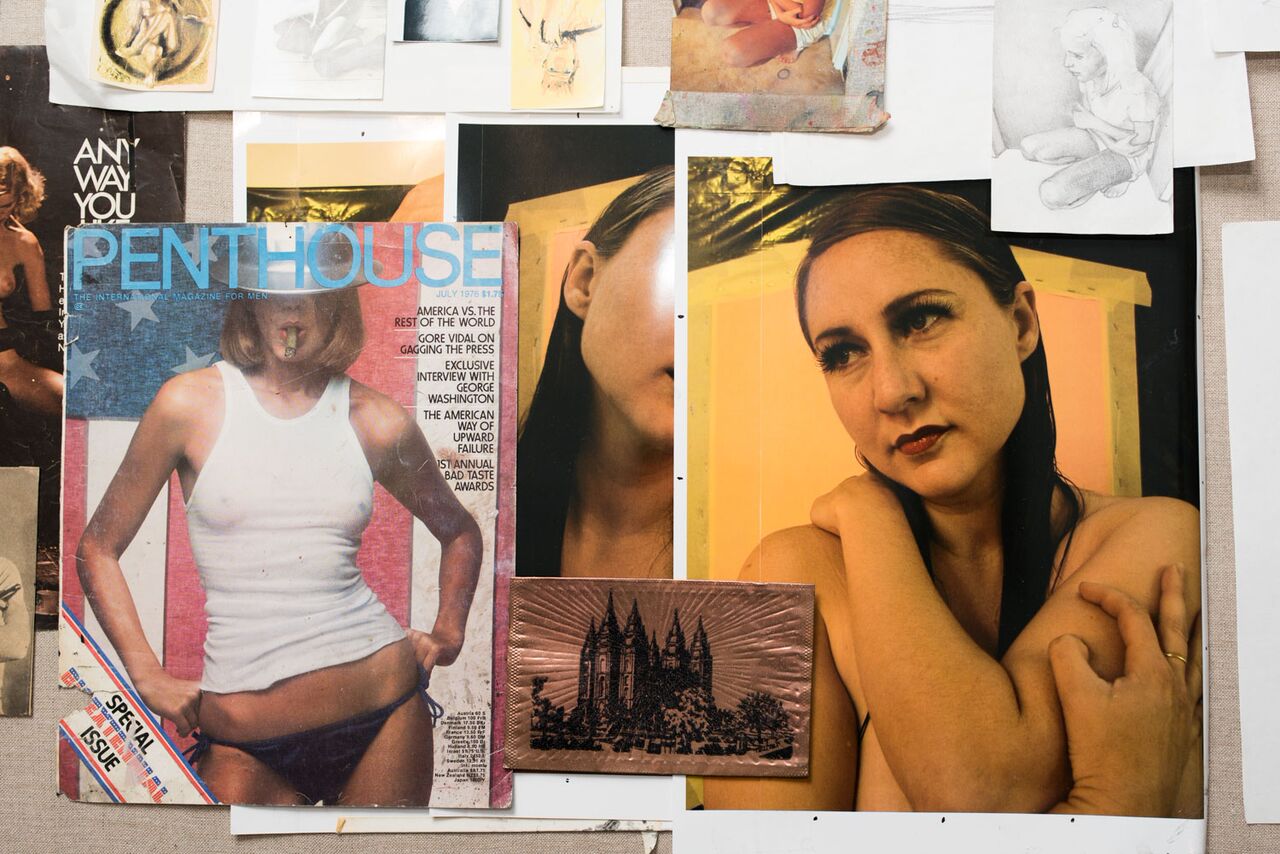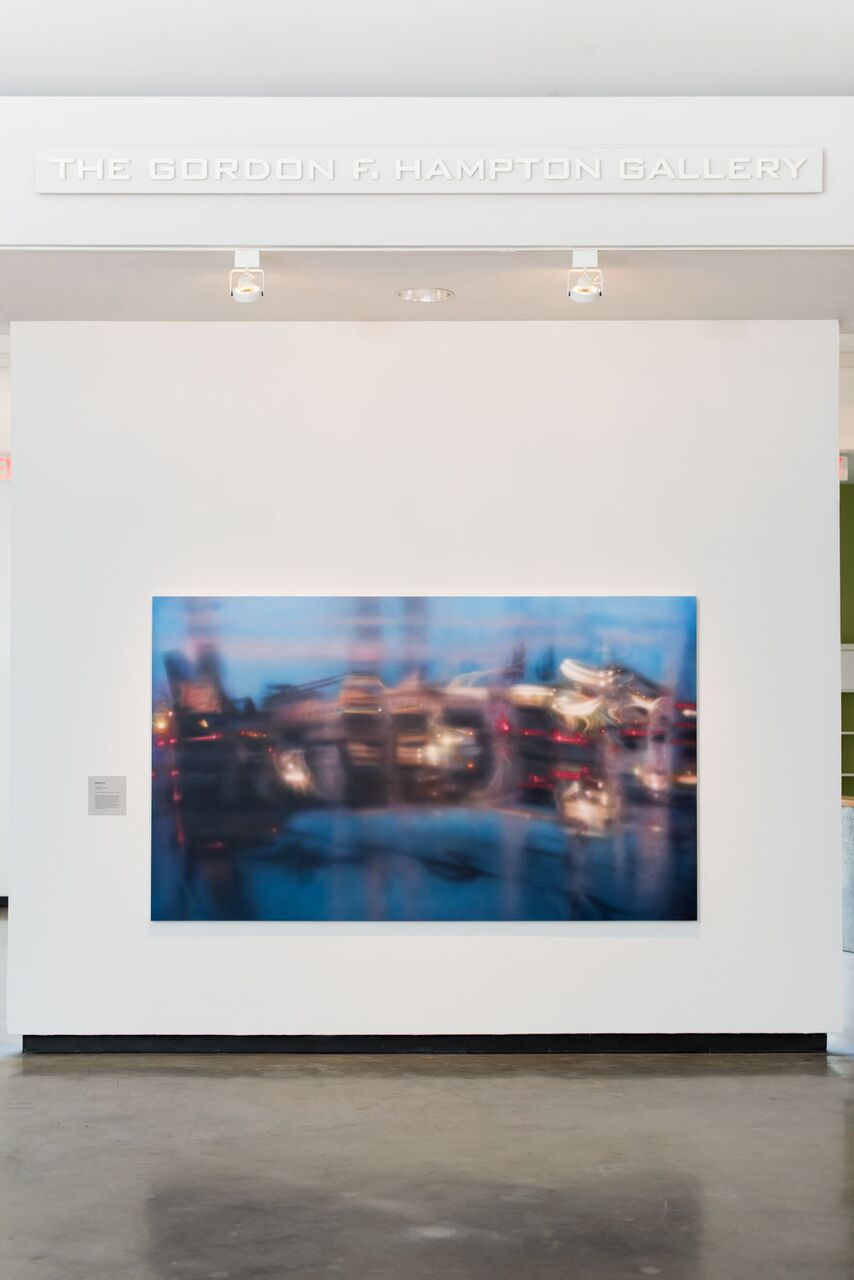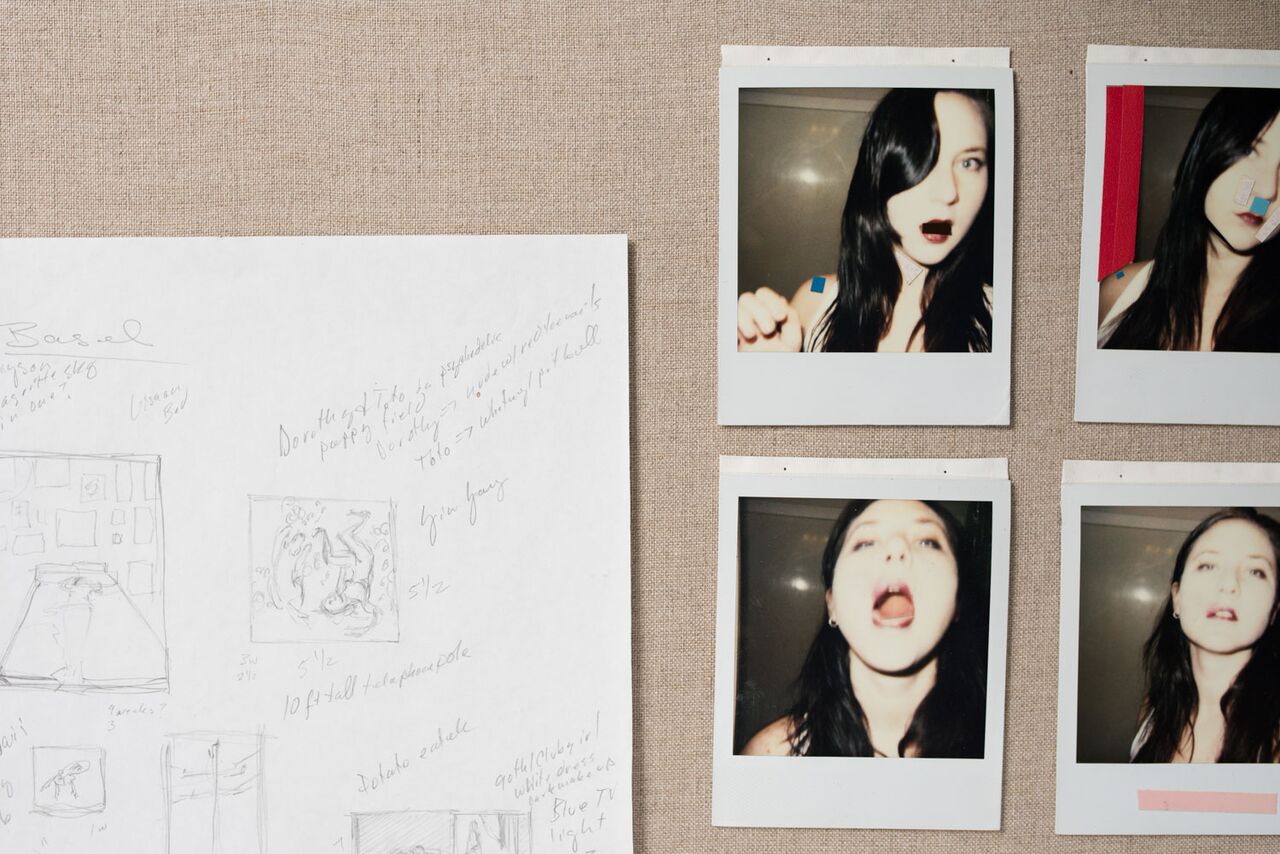
Photos courtesy of the University Art Museum. Paintings pictured above by Samantha Fields: Containment (Series of 48) (2009) and Passenger (2013) courtesy of Samantha Fields and Traywick Contemporary. Oncoming (2012) courtesy of Anonymous (pictured to the right).
It’s not very often that an established artist will show you their behind-the-scenes practices, their sketches and scrawls made before they embark on the finished work to be displayed to the public, oftentimes for an exhibition planned a year or more in advance.
However, in the University Art Museum’s (UAM) latest exhibition, Dreams of Another Time, on view until Sunday, April 10, curator Kristina Newhouse had a vision from an educational perspective, a plan where two important Los Angeles-based artists, both known for their highly refined skills and techniques in painting, would collaborate in a way that would make them both susceptible to new ideas and discoveries.

Rebecca Campbell, “Ephemera” on display from call-and-response collaboration.
In this two-person exhibition, the museum shows narrative paintings, drawings, collages and sculptures by artists Rebecca Campbell and Samantha Fields. In a call-and-response collaboration they began in 2014, Campbell, known for her portraits painted with her signature broad, yet exacting strokes and Fields, who creates nostalgically, “digitally” blurred landscapes, created a visual conversation inspired by their own personal histories, which over the past 18 months became a catalyst for the artists to produce new works.
“The call and response project pushed us both into territory in the work we might not have otherwise explored,” Fields told the Post. “In my work, I started a series of self-portraits, something that I never imagined I would do. In that sense, the call and response allowed us each to open up some space in our very established practices, something that is difficult to do as a mid-career artist.”
“I thought [the call-and-response] might be a good bridge to connect their very different painterly styles and narratives,” said Newhouse. “More than that, I thought the audience would enjoy having insight into the process of creation, executed by two women artists at the top of their game.”

Rebecca Campbell, Miss April 1971 (2015), oil on canvas, 72 x 156 inches. Courtesy of the artist and L.A. Louver, Venice.
The first piece, a collage, that Campbell created for the collaboration, directly led to her painting Miss April 1971, one of the first astounding you works you see as you walk past the UAM’s first gallery wall. Inspired by the April 1971 issue of Playboy magazine, Campbell used tape on the smaller collage and felt compelled to realize it on a much larger scale, calling the initial piece, “beautiful and terrible at the same time[…].”
“There was actual tape on the smaller collage and I loved the different effects it had,” she continued. Those effects varied from violating to seductive, to protective. I was interested in how you could cover something in many different ways and that each one meant something very different.”
Both artists made new work for Dreams of Another Time that address the concept of fracturing, said Fields. In Campbell’s Miss April 1971, she explains, the tape-like strokes are placed between the viewer and the objectified female body, a “pointed reversal of the male gaze.” While in Fields’ painting, Transplant, she depicts an airplane through the window of a second plane dripping with de-icer, “distorting the powerful machine that takes me to and from my family, becoming symbolic of the space between us.”

Samantha Fields, Transplant (2015), acrylic on canvas over panel, 63 x 106 inches. Courtesy of Samantha Fields and Traywick Contemporary.
The title, Transplant, has two meanings for Fields. It refers to her as a California transplant and takes her father into consideration, who was undergoing a heart transplant, the reason for her flying to Ohio. In Dreams of Another Time, family and femininity are two major themes confronted, distorted and questioned by both creatives.
“I hope that people spend some time with the work, it isn’t a fast read,” said Fields.
The “ephemera” from the call-and-response is also on display, showing off Campbell’s “fast, ridiculously imprecise thumbnail sketches,” as described by Fields as gratifying to see, that another artist who creates such technically complex paintings starts off just as loosely. Fields isn’t finished with her series of self portraits, yet, saying she sees the series continuing well past the exhibition. The two will continue to work together this summer at CSU Summer Arts in Monterey, where Campbell will be a guest artist for her advanced studio course.

Rebecca Campbell, “Ephemera” on display from call-and-response collaboration.
“The best take-away, aside by being moved by Rebecca and Sam’s obvious talent and compositional skill, is an understanding that artists never simply ‘arrive’ at mature art practice and stay put,” said Newhouse. “The very best artists are never afraid to open up their practice, take apart the pieces, and reassemble them into something new. It keeps their artwork fresh and leads to new breakthroughs.”
On display alongside Dreams of Another Time are two more exhibitions. “What’s the difference between an art object and a luxury good?” is the question posed by Frenemies: Art Versus Commodity, curated by Museum and Curatorial Studies graduate students Kimberly Bakovic and Crystal Ferrer, under the guidance of Dr. Nizan Shaked. Think Andy Warhol’s iconic Campbell’s Soup Cans created in the 1960s or Michael Elmgreen’s and Ingar Dragset’s Prada Marfa, a one-structure ghost town of a Prada store, its deserted handbags and left-footed shoes contained as mere sculptures in a stoic box surrounded by a lifeless landscape just outside of Valentine, TX.
Described by the UAM as “a quintessentially California artist with strong Long Beach roots,” Thiebaud’s work presented in Wayne Thiebaud: Prints in Process shows the artist’s idea development over decades. The exhibition includes four Thiebaud prints from the UAM’s permanent collection, gifted to the museum by the acclaimed artist himself, and 22 prints from the University Library Gallery at Cal State Sacramento, the artist’s alma mater. Lining the walls of the UAM’s Permanent Collection Gallery are Thiebaud’s etchings, woodcuts, color linocuts, lithography and other print processes marking his colorful depiction of cakes, candies, pies and pastries and his overarching creative process.
For more information on the current exhibitions, click here.
The University Art Museum is located at 1250 Bellflower Boulevard.
{FG_GEOMAP [33.7770433,-118.11439530000001] FG_GEOMAP}

